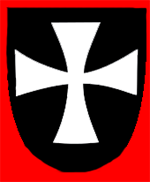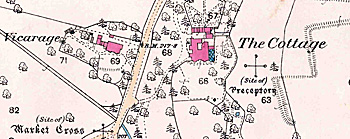Melchbourne Preceptory

Arms of the Knights Hospitaller
Volume I of The Victoria County History for Bedfordshire was published in the early 20th century and has a section on religious houses in the county, amongst which was a preceptory for the Knights Hospitaller of Saint John of Jerusalem at Melchbourne. A preceptory was a headquarters for that particular area and the preceptor answered for the running of the preceptor to the Grand Master.
The preceptory at Melchbourne was founded in the reign of Henry II (1154-1189), the order having been founded in Palestine shortly after the conquest of Jerusalem by the members of the First Crusade in 1099. It was a military order devoted to fighting against the Muslim armies in the region, protecting Christians in Palestine and Syria and administering to the sick.
The Victoria County History states the area was the property of the Bishop of Coutances, reverted to the Crown, and then “passed some time in the 12th century to Alice de Clare, who gave the manor and church of Melchbourne to the Knights of St. John of Jerusalem”. (p.142).
It would appear that “a tenant-in-chief” of Geoffrey de Montbray, the Bishop of Coutances, was Aubrey de Vere 1 (who died circa 1112-1113). Aubrey was also known as Albericus. Among the children of Aubrey de Vere I and his wife Beatrice of Ghent was Aubrey de Vere II, also known as Albericus. Aubrey de Vere I held many estates (Earls Colne in Essex was one of them). His son Aubrey de Vere II (born around 1080, died 1141) married Alice (or Alicia) de Clare, the daughter of Gilbert Fitz Richard de Clare (1055-1117) and Alice (or Adeliza) de Clermont, the daughter of Hugh, Count of Clermont and Margaret de Ramerupt. The de Clare family linked their name to Clare in Suffolk.
Aubrey de Vere II was killed in May 1141 by a London mob where and when King Stephen had sent him with instructions to calm things. His widow, Alice de Clare, had been born in 1080 and became a nun after widowhood, dying at St. Osyth’s Priory in Essex in 1163.
Alice de Clare gave the church and lands around Melchbourne and Riseley to the Knights of St. John of Jerusalem. It is not known precisely when the Melchbourne preceptory was first built. Two descendants of the de Vere family subsequently became Grand Priors of the Order of St. John (Gilbert, 1190-1195, and Roger, 1265-1272).
The preceptory was described by John Leland in his “Itinerary” after a visit around 1536-1538 as old, built of squared stone with much of it vaulted on stone pillars, and beside a park. Leland wrote that a hall had been newly built in the time Sir John Weston was Grand Prior of the Order in England (1476-1489). As this “newly built hall” was at least 45 years old at the time of Leland’s visit this has led to speculation that he may have been referring to the house built for another – the last - Grand Prior, Sir William Weston (Grand Prior 1527-1540), at the other end of Melchbourne around 1528. The cellars of the latter house can still be seen in part of the cellars of present-day Melchbourne House (built around 1612 for the St John of Bletsoe family, who acquired it from the Russell, Dukes of Bedford, family in 1609). The Russell family had acquired it from the Crown after the dissolution of the Order. Sir William Weston died within weeks of the Order’s dissolution having looked “sor syk, and be lyk ded” for several months beforehand.
The other great crusading order was that of the Templars. Those in France were brutally suppressed by King Philip IV (1285-1314) in 1307 and the order was suppressed in the rest of Europe by Pope Clement V (1305-1314) in 1312. Some of their Bedfordshire property seems to have been given to the Hospitallers at Melchbourne.
It is recorded that on two occasions the Hospitallers buried a suicide. This was against Christian practice but the Pope had given the order dispensation to bury anyone who had given them money, whatever the cause of their death. Thus in 1274 and 1285 suicides were buried to whom the Priory at Dunstable had refused Christian burial.
Henry VIII (1509-1547) dissolved all religious houses and orders in England, including houses of the Hospitallers. A list of the preceptory's assets was made in 1540. The original is in The National Archives [SC6 Hen VIII 2402] but a transcription by Y Nicholls is available at Bedfordshire and Luton Archives and Records Service. The preceptory had property in the following places:
- Bedfordshire: Bolnhurst; Dean; Eaton Socon; Harrold; Ickwell; Langford; Little Staughton; Melchbourne; Odell; Pavenham; Pertenhall; Radwell; Riseley; Sharnbrook; Toddington; Turvey
- Cambridgeshire: Southorpe
- Huntingdonshire: Kimbolton; Stonely
- Northamptonshire: Blakesley; Hargrave; Rushden
It is alleged that it was refounded by Mary I (1553-1558) in 1557, being again dissolved on her death.
The Bedfordshire Historic Environment Record [HER] contains information on the county's historic buildings and landscapes and summaries of each entry can now be found online as part of the Heritage Gateway website. The record [HER 342] states: "The site of a preceptory of the Knights Hospitallers founded between 1154 and 1176. It lost its status as a true preceptory in 1489 but was briefly refounded by Queen Mary in 1557. The house was already in decay by the time of a survey of the estate in 1586. Some earthworks survive, comprising a pond and possible hollow way, but the exact site of the preceptory buildings is not known. Part of the area was said to have been levelled during the Second World War, when burials were apparently found: this area seems to be apparent on RAF aerial photos taken in 1945". The site highlighted as that of the preceptory lies east of Knotting Road and north of Melchbourne Park.
The final traces of Melchbourne preceptory were largely eliminated In1944 when the US 8th Air Force were stationed around Melchbourne and the preceptory’s site was bulldozed to make way for a baseball ground.
(*Many thanks to Michael Jefferson for his notes and emendations for this page)

Map showing the site of the Preceptory